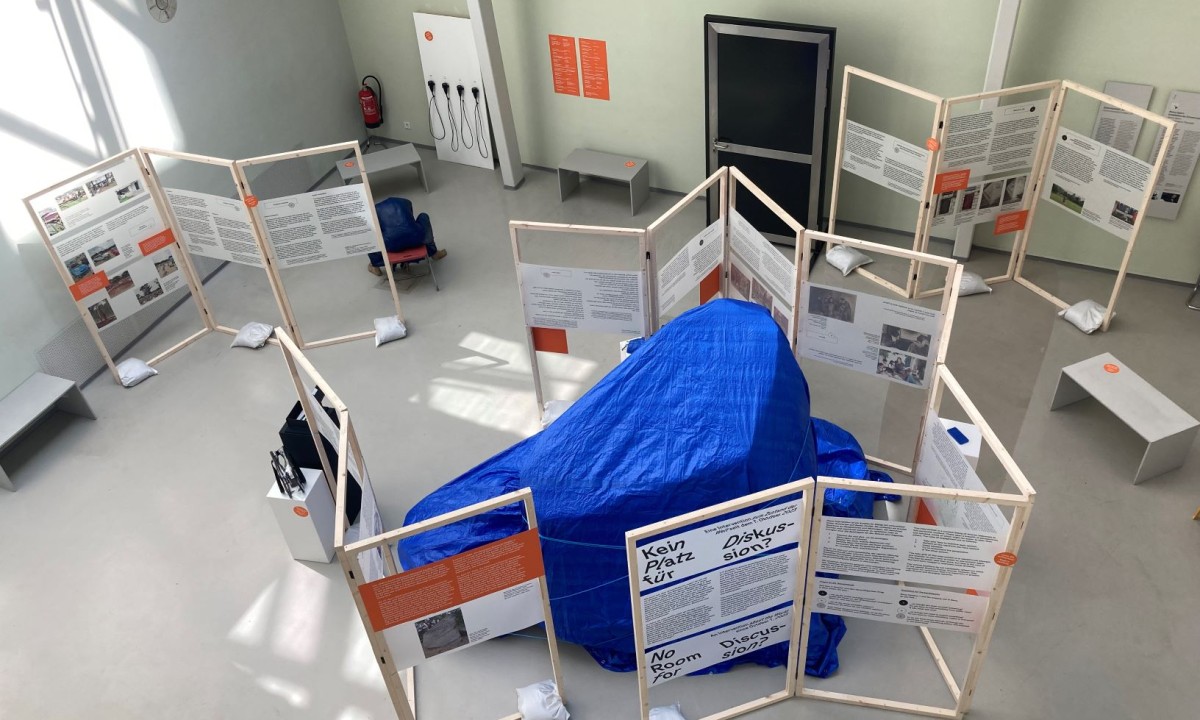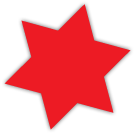Bird’s eye view of No Room for Discussion?
21. May 2025
Behind the Lens
No Room for Discussion? A Soft Opening
by Caitlin Gura & solo ohne - Studio für Gestaltung
On the evening of May 13, 2025, the Jewish Museum Vienna celebrated the launch of its most recent intervention No Room for Discussion? An Intervention about the World since October 7, 2023. Instead of the usual fanfare with music and a program of speeches, the museum decided to hold a “soft opening” for those who were central in bringing this show to life. A small, intimate gathering was just the right format given the challenging topic. The soft opening also reflected the spirit of the small exhibition: having enough space to read and look through the show carefully and to engage in meaningful conversation with one another.
Since the massacre of October 7, 2023, and the on-going war in Gaza, the pressure to “pick sides” has polarized and divided families, friends, and communities and rendered discussions practically impossible. How can we overcome these rifts in a time of increasing antisemitism, racism and hatred against Muslims? How can we make space for informed, differentiated, civil conversations again? These questions, among others, form the crux of the intervention No Room for Discussion?

© Caitlin Gura, Jüdisches Museum Wien
View of Intervention No Room for Discussion?
The starting point of this project was a particular incident in London’s Hyde Park on April 27, 2024, when the Holocaust Memorial was covered as a preventative measure against vandalism during a pro-Palestinian demonstration. Although cordoning off monuments during major events is standard procedure for Royal Parks authorities, the Holocaust Memorial was the only one covered. This decision was met with much backlash from politicians, Jewish communities, and Holocaust organizations.
This incident spurred me to ask people living in Vienna and those working at European Jewish Museums who are confronted with this issue on a daily basis, both personally and professionally, whether they feel like they have to keep something about themselves concealed, exposed, or a mix of both. The responses I received created the exhibition. They reflect a broad spectrum of views and opinions and come from a plurality of voices: Jewish, Muslim – both religious and secular –, public institutions, organizations, and private individuals. The responses provide visitors with the opportunity to read and try to understand each person’s and organization’s perspectives. As the curator of this mini exhibition, I found that we all must learn to listen to each other again, especially to someone of an opposing viewpoint from our own. Admittedly, that is easier said than done, but we all have to start somewhere and try our best.

© Caitlin Gura, Jüdisches Museum Wien
A visitor interacts with Lament, an installation piece by Inbal Volpo and Osama Zatar of OneState Embassy
On the Exhibition Design by solo ohne - Studio für Gestaltung:
The graphic and architectural design aims to capture and support the curatorial concept both visually and spatially. The wooden structures provide the framework for this exhibition project as well as the participants’ responses. Arranged around the facsimile of the Holocaust monument, these structures create additional layers of content and context whenever visitors look at this central object.
The mobile wooden frames structure the exhibition space and guide visitors through the participants’ responses. Depending on how the light falls, the faintly translucent text panels allow the background to shine through and evoke a feeling of transparency and permeability. The text font is purposely slanted at various angles – sometimes in line with the reading flow and at some points against it – to illustrate complexity, ambiguity, and the various ways of reading this exhibition. The orange-colored text panels provide an additional level of explanation.
Tarps, covered objects, untreated wood, and sandbags evoke the image of construction sites. These elements exemplify that intensive, informed discussion is a constant, on-going process.
The graphic and architectural design aims to capture and support the curatorial concept both visually and spatially. The wooden structures provide the framework for this exhibition project as well as the participants’ responses. Arranged around the facsimile of the Holocaust monument, these structures create additional layers of content and context whenever visitors look at this central object.
The mobile wooden frames structure the exhibition space and guide visitors through the participants’ responses. Depending on how the light falls, the faintly translucent text panels allow the background to shine through and evoke a feeling of transparency and permeability. The text font is purposely slanted at various angles – sometimes in line with the reading flow and at some points against it – to illustrate complexity, ambiguity, and the various ways of reading this exhibition. The orange-colored text panels provide an additional level of explanation.
Tarps, covered objects, untreated wood, and sandbags evoke the image of construction sites. These elements exemplify that intensive, informed discussion is a constant, on-going process.

© Peter Wildgruber, Jüdisches Museum Wien
(left to right): Stezi Koch (solo ohne), Caitlin Gura (JMW), Sebastian Hierner (solo ohne)
The participants transformed the museum into a space for dialog on one of the most challenging topics of our time. For their openness, honesty, and willingness to participate, I personally would like to thank:
- Doron Rabinovici
- Mitchell Ash
- Anne Pritchard-Smith
- Litzi Yona
- Inbal Volpo & Osama Zatar of OneState Embassy artist collective
- Emile Shrijver of the Jewish Museum Amsterdam
- Barbara Cuglietta, Bruno Benvindo und Ariane Defrain of the Jewish Museum Belgium
- Dennis Pazashvili of the Jewish Museum Vienna
- Rusen Timur Aksak
- The Jewish Students’ Union of Austria, represented by Alon Ishay, Manuli Turkof, Jennifer Leviev & Adrian Jonas Haim
- Those who wished to remain anonymous
I would also like to recognize the following for their contributions:
- Lukas Spreitzer: facsimile of the Hyde Park Holocaust memorial
- KB Metall Technik GmbH: production of the security door on display for the response of the Jewish Students’ Union of Austria
- Plan B Crew GmbH & Large Format by e.h. montagen: architectural production and printing
- All those with whom I had countless honest conversations as I prepared for this project. Your kind feedback was greatly appreciated!
To the visitors of this small exhibition, I kindly ask you to take your time, reflect, listen, take a break, think things through – before discussing with one another. Perhaps that way, we can repair the rifts together.
The Intervention "No Room for Discussion?" is on view at Museum Dorotheergasse until September 14, 2025.
The Intervention "No Room for Discussion?" is on view at Museum Dorotheergasse until September 14, 2025.

© Alicia Meier, Jüdisches Museum Wien

© Alicia Meier, Jüdisches Museum Wien
Visitors walk through the intervention

© Alicia Meier, Jüdisches Museum Wien
Bird’s eye view of opening night

© Alicia Meier, Jüdisches Museum Wien
Director Barbara Staudinger and Curator Caitlin Gura

